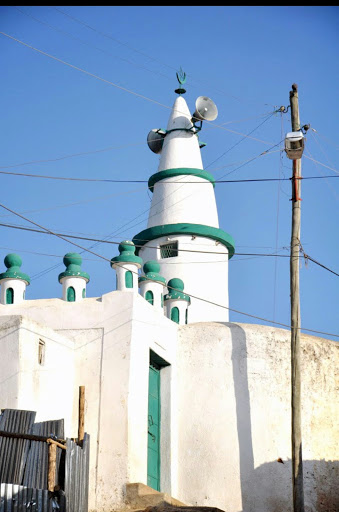Din Agobara Mosque Oldest mosque in jugalin agobera is belived its one the three mosques in the old city

that are dated before 10th century when it was built it is build according to harare house constrution style ,

The mosques of Harar have been the focus of some architectural and historical study but not archaeological investigation. This was redressed through excavation of six mosques in the city, the results of which are presented. These were identified from existing historical research as significant in the Islamization of Harar. Consensus on either the date or processes of Islamization does not exist. The partial history of the mosques investigated – Aw Abdal, Aw Abadir, Aw Meshad, Din Agobera, Fehkredin, Jami – is based on only a few sources. The results of the excavations provide insights into the Islamization of Harar and supplement the limited historical sources. The six radiocarbon dates obtained indicate a varied mosque chronology spanning the late 15th and early 20th centuries AD. Evidence indicative of the use of mosques for educational purposes, local practices such as animal sacrifice and child burial near the mihrab, and for extensive mosque rebuilding, alteration and remodelling was found. Comparable mosques in Djibouti, Somaliland, and elsewhere in Ethiopia are considered. It is concluded that all the Harari mosques investigated post-date the late 15th century and that the city also dates from this era and was linked with the establishment of Harar as the capital of Adal. Prior to this the Hararis, likely in the form of the legendary Harla, were elsewhere, possibly at Harlaa and other sites in the eastern Harar Plateau and Chercher Mountains.
History and Features of the Mosques of Harar The unpublished handwritten BA dissertation by Zekaria (1979) provides the most comprehensive historical documentation on the mosques of Harar. Because of its importance and inaccessibility, it is drawn upon extensively here. Previous studies are limited and mentions of the mosques include those by Burton (1894: 4), who refers to the city as abounding in mosques, “plain buildings without minarets”, as well as those of Cerulli (1971: 405) and Paulitschke (1888: 206-207). Subsequent research has also been restricted and exceptions include a short summary of Harar mosque architecture provided by Horton (1994: 196-197) that draws on Zekaria (1979), another by Santelli (2008: 631-632), and references to the mosques in guidebooks, notably Chiari (2015: 38-40). A comprehensive map of the mosque locations has also been completed by the University of Rome La Sapienza and the Harari People’s National Regional State (CIRPS 2003). In total, 88 mosques were extant in Harar in 1979, with 82 inside the walled city, and six outside (Zekaria 1979). This figure appears to have remained constant with 82 mosques also recorded within the city walls by the Interuniversity Research Center for Sustainable Development (CIRPS) at the University of Rome La Sapienza’, and the Harari People’s National Regional State (CIRPS 2003). The number of mosques is more or less equally distributed in each of the 4 five city quarters with about 17 mosques each. The five city quarters were subdivided into toyach, “neighbourhoods”, with more than sixty of these named after either saints or the business activity of the area (Zekaria 1979: 22). These were then further divided into lazims which were also often named after mosques (Ahmed 1990: 325).
. Additionally, Harar contains a large number of saint’s shrines distinct from mosques, leading to its alternative name as Madīnat al-Awliyā or ‘City of Saints’ (Gibb 2000: 25). The precise number of these shrines is not known (Zekaria 2003: 19), though suggestions have been made, with a total of 103 shrines provided by Santelli (2008: 631), and 107 Saints names given by Wagner (1973; cf. Braukämper 2004: 113), or the figure of 272 saints names recorded by Gibb (2000: 26), the latter including important female saints such as Āi ‘Abīda, the “mother of Harar” (Gibb 2000: 36). Mosques can also be named through their association with Saints and Shaikhs (Muslim scholars and notables) or the neighbourhood they are located in. The literal meaning of “Aw” or ‘āwach is “father”, and is also the common term for “saint” in Harari (Gibb 2000: 27; Zekaria 2003: 23-24) and is used in the names of mosques that refer to saints. It is also apparent that some mosques have lost their original names and have been assigned new ones (Zekaria 1979: 22).

